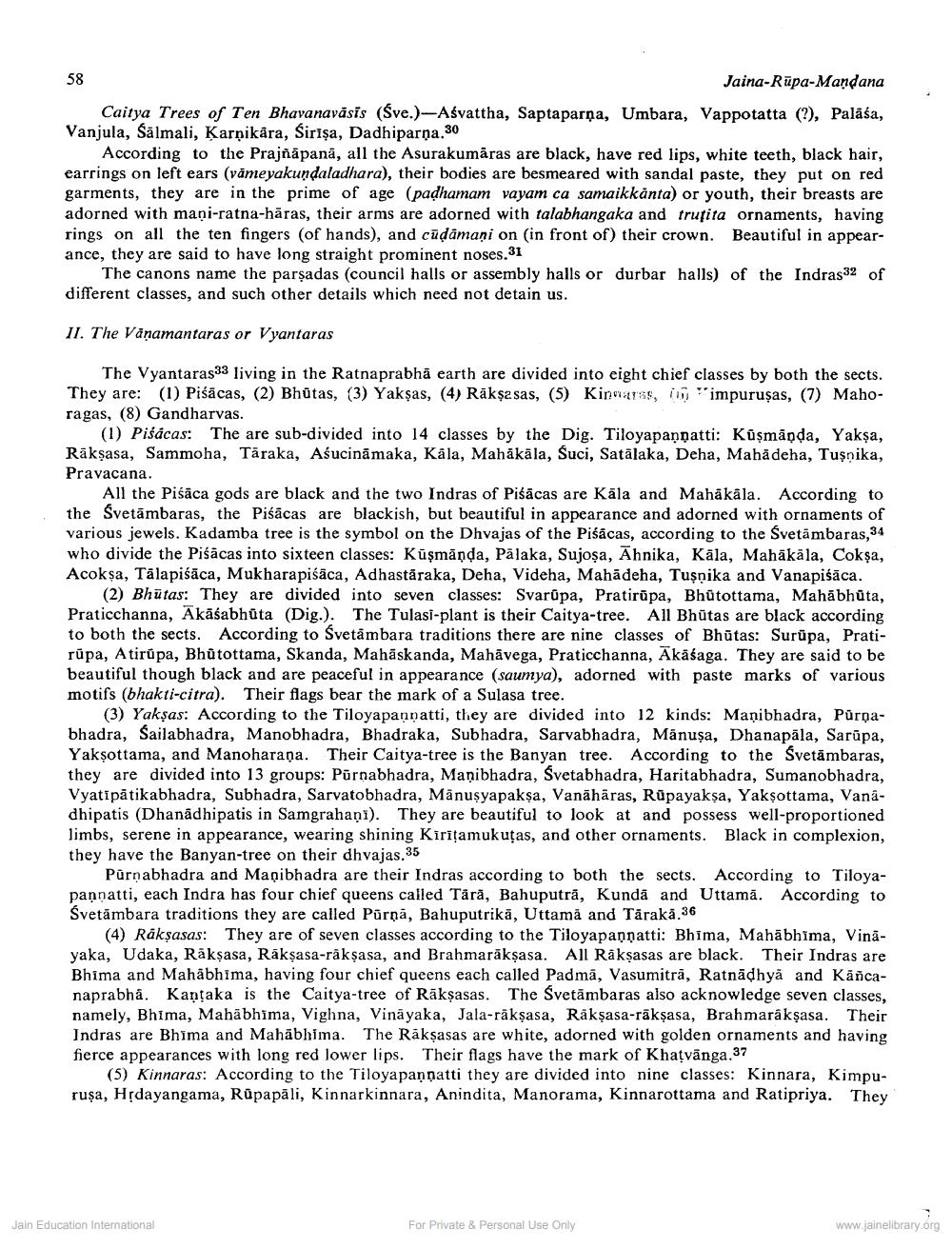________________
58
Jaina-Rupa-Mandana Caitya Trees of Ten Bhavanavāsis (Śve.)-Asvattha, Saptaparna, Umbara, Vappotatta (?), Palasa, Vanjula, Salmali, Karpikara, Sirtşa, Dadhiparoa.30
According to the Prajñāpanā, all the Asurakumāras are black, have red lips, white teeth, black hair, earrings on left ears (vāmeyakuṇḍaladhara), their bodies are besmeared with sandal paste, they put on red garments, they are in the prime of age (padhamam vayam ca samaikkanta) or youth, their breasts are adorned with maṇi-ratna-hāras, their arms are adorned with talabhangaka and truțita ornaments, having rings on all the ten fingers (of hands), and cuḍāmaṇi on (in front of) their crown. Beautiful in appearance, they are said to have long straight prominent noses.31
The canons name the parṣadas (council halls or assembly halls or durbar halls) of the Indras32 of different classes, and such other details which need not detain us.
II. The Vaṇamantaras or Vyantaras
The Vyantaras33 living in the Ratnaprabha earth are divided into eight chief classes by both the sects. They are: (1) Pisacas, (2) Bhūtas, (3) Yakṣas, (4) Rākṣasas, (5) Kinnaras, impurusas, (7) Mahoragas, (8) Gandharvas.
(1) Pisacas: The are sub-divided into 14 classes by the Dig. Tiloyapaṇṇatti: Kūṣmaṇḍa, Yakṣa, Rākṣasa, Sammoha, Taraka, Aśucināmaka, Kala, Mahākāla, Suci, Satalaka, Deha, Mahādeha, Tuşnika, Pravacana.
34
All the Pisaca gods are black and the two Indras of Piśācas are Kāla and Mahākāla. According to the Svetambaras, the Pisacas are blackish, but beautiful in appearance and adorned with ornaments of various jewels. Kadamba tree is the symbol on the Dhvajas of the Pisacas, according to the Svetämbaras,3 who divide the Pisacas into sixteen classes: Kūṣmaṇḍa, Pālaka, Sujoșa, Āhnika, Kāla, Mahākāla, Cokṣa, Acokṣa, Talapiśāca, Mukharapiśāca, Adhastāraka, Deha, Videha, Mahādeha, Tuṣṇika and Vanapiśāca.
(2) Bhutas: They are divided into seven classes: Svarupa, Pratirupa, Bhūtottama, Mahābhūta, Praticchanna, Akāśabhūta (Dig.). The Tulasi-plant is their Caitya-tree. All Bhutas are black according to both the sects. According to Svetambara traditions there are nine classes of Bhutas: Surupa, Pratirūpa, Atirúpa, Bhutottama, Skanda, Mahāskanda, Mahāvega, Praticchanna, Akāśaga. They are said to be beautiful though black and are peaceful in appearance (saumya), adorned with paste marks of various motifs (bhakti-citra). Their flags bear the mark of a Sulasa tree.
(3) Yakṣas: According to the Tiloyapanṇatti, they are divided into 12 kinds: Manibhadra, Pūrṇabhadra, Śailabhadra, Manobhadra, Bhadraka, Subhadra, Sarvabhadra, Mănușa, Dhanapala, Sarupa, Yakṣottama, and Manoharana. Their Caitya-tree is the Banyan tree. According to the Svetambaras, they are divided into 13 groups: Pūrṇabhadra, Manibhadra, Svetabhadra, Haritabhadra, Sumanobhadra, Vyatipatikabhadra, Subhadra, Sarvatobhadra, Manuṣyapakṣa, Vanāhāras, Rūpayakṣa, Yakşottama, Vanadhipatis (Dhanadhipatis in Samgrahapi). They are beautiful to look at and possess well-proportioned limbs, serene in appearance, wearing shining Kirițamukutas, and other ornaments. Black in complexion, they have the Banyan-tree on their dhvajas.35
Pūrṇabhadra and Manibhadra are their Indras according to both the sects. According to Tiloyapannatti, each Indra has four chief queens called Tārā, Bahuputrā, Kunda and Uttamă. According to Śvetämbara traditions they are called Pūrṇa, Bahuputrikā, Uttamā and Tārakā.36
(4) Rākṣasas: They are of seven classes according to the Tiloyapanṇatti: Bhima, Mahābhima, Vināyaka, Udaka, Rākṣasa, Rākṣasa-rakṣasa, and Brahmarākṣasa. All Rākṣasas are black. Their Indras are Bhima and Mahābhima, having four chief queens each called Padmā, Vasumitra, Ratnaḍhya and Kancanaprabha. Kaṇṭaka is the Caitya-tree of Rākṣasas. The Svetambaras also acknowledge seven classes, namely, Bhima, Mahābhima, Vighna, Vinayaka, Jala-rākṣasa, Rākṣasa-rākṣasa, Brahmarakṣasa. Their Indras are Bhima and Mahābhima. The Rakṣasas are white, adorned with golden ornaments and having fierce appearances with long red lower lips. Their flags have the mark of Khatvanga.37
(5) Kinnaras: According to the Tiloyapanṇatti they are divided into nine classes: Kinnara, Kimpuruşa, Hrdayangama, Rūpapāli, Kinnarkinnara, Anindita, Manorama, Kinnarottama and Ratipriya. They
Jain Education International
For Private & Personal Use Only
www.jainelibrary.org




